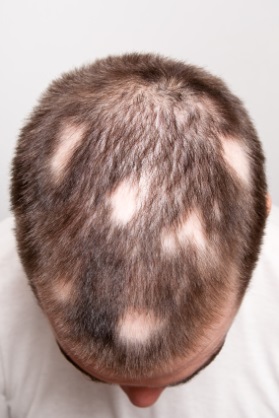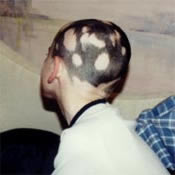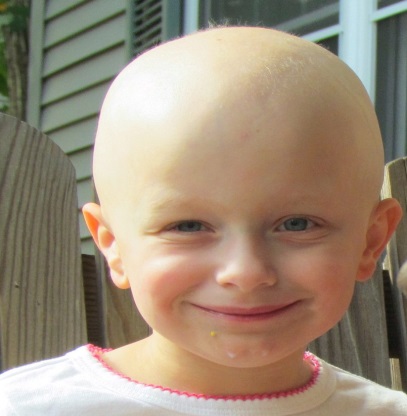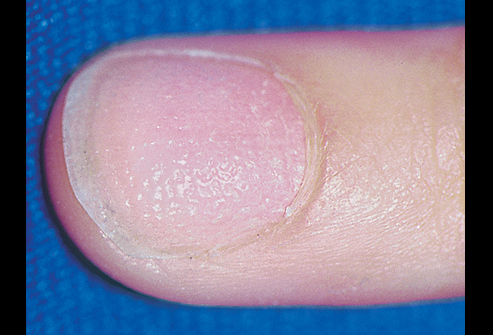Alopecia simply means ‘hair loss’ in general medical term.
There are different types of hair loss, presenting with different symptoms and has different underlying causes.
Alopecia Areata
The estimates of the number of people affected vary between 1 in 1,000 to 2 in 100 at some point in their life. Most cases of alopecia areata first develop during the teenage years and children but they can develop at any age. In about 6 in 10 cases the first patch of hair loss develops before the age of 20 years.
Males and females are equally affected in younger age groups but those affected later on are mainly women. The condition tends to be milder when it first develops at an older age.
What is alopecia areata?
Alopecia areata is a specific, common cause of hair loss. This describes patches, usually causes small, coin-sized, round patches of baldness on the scalp, although hair elsewhere such as the beard, eyebrows, eyelashes, body and limbs can be affected. In some people larger areas are affected and occasionally it can involve the whole scalp (alopecia totalis) or even the entire body and scalp (alopecia universalis).
It is impossible to predict how severe the alopecia is. Regrowth of hair in typical alopecia areata is usual over a period of months or sometimes years, but cannot be guaranteed. The chances of the hair regrowing are better if less hair is lost at the beginning. Most people, with only a few small patches get full regrowth within a year. If more than half the hair is lost then the chances of a full recovery are not good.
The hair sometimes regrows white, at least in the first instance. Most people get further attacks of alopecia areata. In alopecia totalis and alopecia universalis, the likelihood of total regrowth is less.
What causes alopecia areata?
Inflammation causes hair loss but the cause of this inflammation is unknown. However, it is postulated that the immune system natural defense which normally protects the body from infections and other diseases, may attack the growing hair. The reason this happens is not fully understood, nor is it known why only localized areas are affected and why the hair usually regrows again.
A person suffering from alopecia areata is slightly more likely than a person without it to develop autoimmune diseases such as thyroid disease, diabetes, lupus and vitiligo (white patches on the skin).
However the risk of getting these disorders is still very low. If symptoms of these conditions are present, they should be investigated accordingly.
It is not contagious, not associated with food or vitamin deficiencies. Stress may appear to be a possible trigger for alopecia areata but it is thought by many to be coincidental as many of those affected have no significant stress.
Genetic predisposition plays a role and close family members may be affected.
What are the symptoms? What does alopecia areata look like?
There may be a tingling sensation in the scalp. It can be a very upsetting condition to the sufferer, especially if the bald area cannot be disguised by hairstyle.
If alopecia areata affects the eyelashes, then the eyes may become sore due to dust, particularly in dry and windy conditions.
They typically begin as one or more bald, smooth patches on the scalp, which are not red or flaky. It tends to affect pigmented hair so there may be some white hairs left within the bald area in older people. Exclamation mark hairs (short, tapered hairs) are characteristic of alopecia areata, may be seen at the edge of the bald patch.
Regrowth usually starts at the centre of the bald patch with fine white hair that thickens with time and usually regains its colour. Some develop small pits on their nails.
 |
 |
 |
|
(1) |
(2) | (3) |
Picture (1) and (2) showing patchy hair loss and picture (3) showing total hair loss over scalp and eyebrows.
 |
| (4) Showing nail pitting in a patient with alopecia areata |
Can it be cured?
Alopecia areata cannot be cured. If the hair loss is patchy, there is a good chance (up to 80% depending on how extensive it is) that there will be complete regrowth within 1 year without treatment. Further episodes of hair loss may occur again in future. If there is very extensive hair loss from the very start, the chances of it regrowing are not as good. Only about 1 in 10 makes full recovery in those with more than half the hair loss at any stage. Outcome is not so good in young children and those with the condition affecting the hairline the front, side or back.
How can alopecia areata be treated?
Mild early alopecia areata has the likelihood for spontaneous regrowth and thus they may not need treatment. Some treatment can induce hair growth, though none is able to alter the overall course of the disease.
Available treatment:
Steroid creams and scalp applications
These are applied to the bald patches, usually twice a day, for a limited time. They are particularly useful for patchy hair loss.
Local steroid injections
These can be used on the scalp and brows, and are the most effective approach for small patches of hair loss. Injections can be repeated every few months. A small dimple may develop at the injection sites, but this usually recovers after a few months. Special care is taken around the eyes, when injecting the brows, as injecting too much may cause glaucoma (raised pressure inside the eyeball).
Immunotherapy
This involves applying chemicals to stimulate hair growth by causing an intentional allergic reaction in the affected areas of skin. An example that is available here is squaric acid dibutylester (SADBE). Immunotherapy are particularly useful for extensive hair loss ie alopecia totalis and alopecia universalis.
Steroid tablets
Large doses of steroid tablets may result in regrowth of the hair, but when the treatment stops the alopecia often recurs. Taking steroids by mouth over a period of time can cause many side effects including raised blood pressure, diabetes, stomach ulcers, cataracts and osteoporosis as well as weight gain.
Psoralen combined with ultraviolet A (PUVA) light therapy or phototherapy
This therapy has been used with limited success. This treatment requires many light therapy session in the hospital.
What can I do?
- Some individuals with alopecia areata will prefer to wear a wig while they wait for recovery.
- Remember to use sunblock or a hat to protect bald patches when out in the sun.
- Support group may be of benefit for the older children. It may help to speak to other people in the same situation eg through online forums. No support groups available in Malaysia but you may want to try the following for further help and advice.
- alopeciaonline.org.uk
- alopecia-awareness.org.uk
- Hair loss can affect self-confidence and sometimes lead to depression particularly among older children and adolescents. It may be of benefit to speak to a counselor or psychiatrist.
References:
- http://www.nhs.uk/conditions/hair-loss/Pages/Introduction.aspx (alopecia) – NHS Choices.htm
- http://www.bad.org.uk/site/795/default.aspx
- http://www.patient.co.uk/health/Alopecia-Areata.htm
| Last Reviewed | : | 28 June 2016 |
| Writer | : | Dr. Wee Ai Leen |
| Accreditor | : | Dr. Sabeera Begum bt. Kader Ibrahim |







